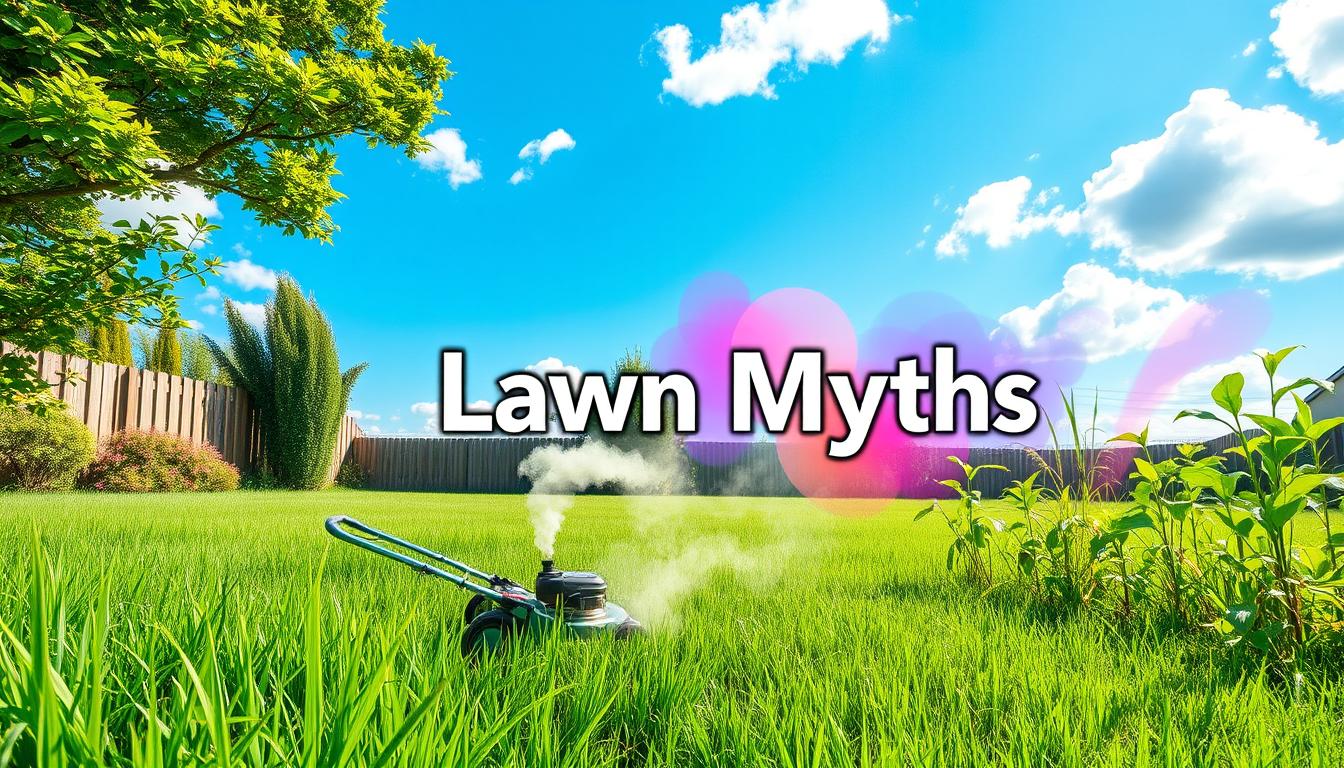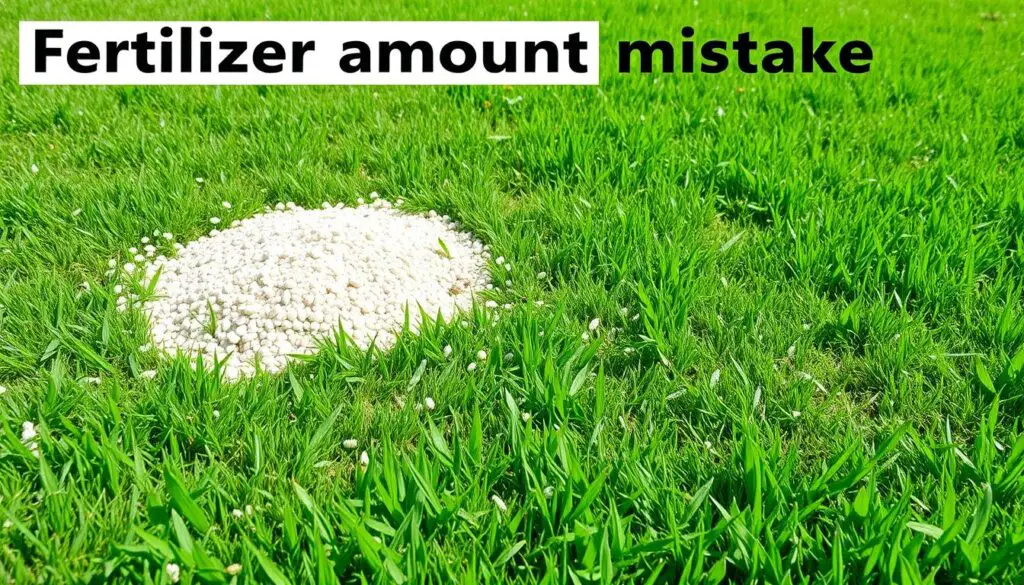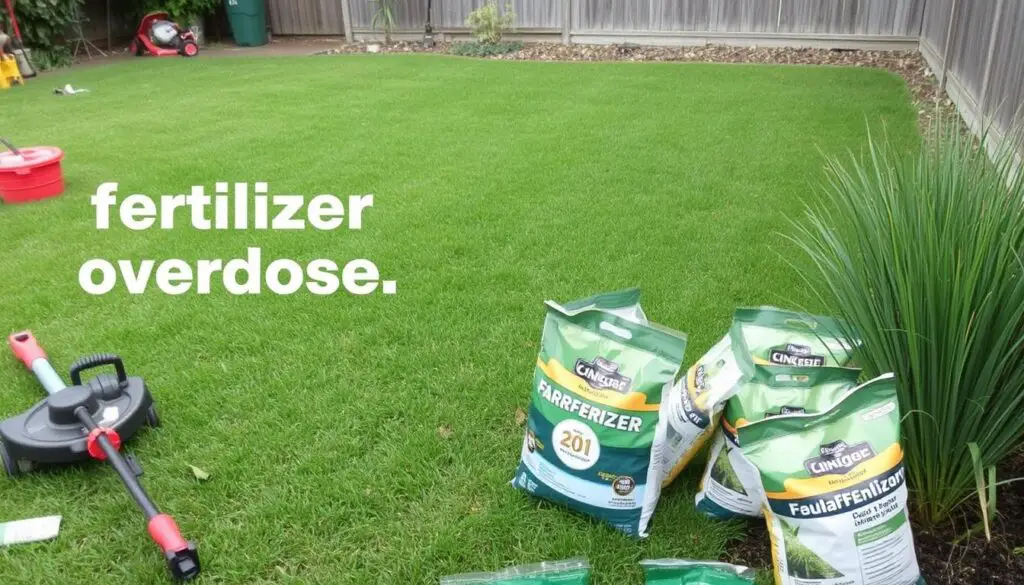Lawn Care Myths Debunked

Did you know over 75% of homeowners believe lawn care myths? These myths can harm your grass and landscape. They include mowing too short and overwatering. As a professional copywriter, I’m here to clear up these myths.
I’ll share proven strategies to make your outdoor space lush and healthy. This will save you time and money.
Key Takeaways
- Cutting grass more than one-third of its height at a time can damage the lawn
- Watering in the early morning or evening is more effective than midday watering
- Overseeding and dethatching are critical for a healthy, weed-free lawn
- Proper mowing height and lawn aeration can reduce weed growth
- Using the right amount of fertilizer is key to nurturing nutrient-rich grass
Uncovering the Truth: Common Lawn Care Misconceptions
Many homeowners believe in lawn care myths that can harm their lawns. These myths include mowing too short to save time and wrong ideas about watering, fertilizing, and weed control. It’s time to learn the truth to care for our lawns right.
Separating Fact from Fiction in Lawn Maintenance
Cutting grass too short is a common myth. It actually makes the soil more exposed, leading to weeds and stressed grass. The best mowing height is 3-4 inches, depending on the grass type, to keep the lawn healthy and dense.
Another myth is that adding more microorganisms to the soil increases their numbers. While microbes are vital, just adding more won’t help. To support a healthy microbial community, focus on aeration, overseeding, and organic fertilizers.
Gypsum is not a solution for raising soil pH, as many think. It doesn’t change the soil’s pH. Instead, use lime or sulfur to adjust the pH as needed.
| Lawn Care Myth | The Truth |
|---|---|
| Cutting grass extremely short reduces mowing frequency | Cutting grass too short exposes the soil, leading to more weed growth and stress on the grass plants |
| Adding more microorganisms to the soil increases their populations | Maintaining a balanced soil ecosystem through proper aeration, overseeding, and organic fertilizers is the key to nurturing a vibrant microbial community |
| Gypsum raises soil pH | Gypsum has no effect on soil pH, and using it unnecessarily can lead to imbalances in the soil |
By debunking these myths, we can better care for our lawns. Stay tuned for more truths about lawn care.
Mowing Myths: The Ideal Grass Height Dilemma
Many people think cutting grass very short means you won’t have to mow as often. But, this can harm your lawn. Cutting too much at once stresses the grass, making it more likely to get sick or damaged.
The best height for most cool-season grasses, like fescue, is 2.5 to 3 inches. In summer, when it’s hotter, raise it to 3 to 3.5 inches. This helps the grass grow deeper roots and fight off drought and heat better. It also keeps the soil shaded, stopping weeds and keeping the lawn green.
For warm-season grasses like Bermuda and Zoysia, mow them as short as you can without hurting the lawn. Still, keep at least one-third of the leaf blade height. Sharp mower blades are key to avoid tearing the grass, which can cause diseases.
| Grass Type | Ideal Mowing Height |
|---|---|
| Fescue | 2.5 to 3 inches (regular season) 3 to 3.5 inches (summer) |
| Bermuda and Zoysia | As low as possible without scalping, but maintaining at least one-third of the total leaf blade height |
Proper mowing height is just one part of a healthy lawn. Also, leave grass clippings on the lawn, keep mower blades sharp, and water it about an inch a week in summer. These steps help your lawn stay lush and green.

“Mowing at the proper height allows the grass to develop deeper roots and better withstand drought and heat.” – Sam, lawn specialist
By sticking to these mowing tips, you can avoid the myth of short mowing. Enjoy a strong, beautiful lawn all year round.
Watering Wisdom: Debunking Irrigation Fallacies
Many people think they need to water their grass every day. But this can actually harm your lawn. Deep, infrequent watering is much better for its health and life span.
Shallow, frequent watering causes grass to have shallow roots. It also uses more water. The best way is to water 1 inch deep for every 12 inches of soil, every 2-3 days. This helps grass grow deeper roots, making it stronger against drought and heat.
Achieving a Lush, Green Lawn with Proper Hydration
When to water is also important. Watering in the early morning or evening helps the grass absorb water better. This small change can greatly improve your lawn’s health and look.
“Watering deeply, but only every 2-3 days, encourages the grass to develop deeper roots that can better withstand drought and heat stress.” – Sam, author of The Mowers Guide
By not believing the myth of daily watering, you can save time, water, and money. Learning how to water your lawn right is key to a beautiful outdoor space.
| Myth | Fact |
|---|---|
| Grass needs to be watered every day | Deep, infrequent watering (every 2-3 days) is more beneficial |
| Shallow, frequent watering is ideal | Leads to a shallow root system and increased water usage |
| Watering in the middle of the day is best | Early morning or evening watering minimizes evaporation loss |
Fertilizer Facts: Avoiding Over or Under-Application
Fertilizer is key for a lush lawn, but myths abound. Many think more fertilizer means a greener lawn. Yet, too much or too little can harm your lawn. The goal is to find the right balance, using the right fertilizer at the right times.
Striking the Perfect Balance for Nutrient-Rich Grass
Slow-release, balanced fertilizers are best. They give your lawn the nutrients it needs without harm. Too much fertilizer can hurt your lawn’s roots, making it weak to disease. Fertilizing in the fall helps your lawn get ready for winter and spring.
To avoid common lawn fertilization myths, know your grass type and the right fertilizer ratio. The numbers on the fertilizer package, like 12-34-56, tell you the mix. Follow the guidelines and adjust for the season and lawn health for a thriving lawn all year.
“Applying the right amount of the right fertilizer at the right time is key to maintaining a lush, green lawn.” – Sam, lawn expert

Remember, moderation is key in lawn fertilization. With the right balance, your lawn will be the envy of the neighborhood. You’ll avoid the dangers of too much or too little fertilizer.
Weed Control: Myths and Realities
Keeping your lawn weed-free can be tricky. Many homeowners believe a single weed killer application will do the job. But, the truth is, getting rid of weeds takes more than just one spray.
Pre-emergent herbicides stop weed seeds before they grow. Post-emergent products tackle weeds that are already there. Some weeds, like crabgrass, need more than one treatment to disappear. Also, different weeds need different treatments to work well.
- A single application of weed killer is not enough to eliminate all weeds.
- Pre-emergent herbicides target weed seeds, while post-emergent products control existing weeds.
- Certain weeds, like crabgrass, may need multiple herbicide applications to fully eradicate.
- Grassy and broadleaf weeds require different treatment approaches.
Knowing how to control weeds is key to a weed-free lawn. By understanding these myths and using a complete strategy, you can have the green lawn you’ve always wanted.
Lawn Care Myths: Exploring Misconceptions
Keeping a lawn healthy and green can be tough. It’s hard to know what’s true and what’s not. Lawn care is full of myths that can hurt our grass. By clearing up these lawn care myths, we can use better methods to keep our lawns looking great.
One big myth is that cutting the grass very short means you won’t have to mow as often. But, mowing the grass at a shorter actually means you’ll have to mow more often. For example, cool-season grass mowed at 2 inches needs mowing every 5 days. But, mowing at 3 inches only needs mowing every 7 days. Cutting the grass too short can weaken it, making it more prone to diseases and pests.
Another myth is that watering the lawn every day is best. But, watering it once a week with 1 inch of water is better for the roots. Watering too much can harm the roots, making the lawn less strong.
| Myth | Reality |
|---|---|
| Grass clippings cause thatch buildup. | Thatch is a mix of dead and living grass parts, and needs special care based on the grass type and season. |
| Applying lime to the lawn every year is necessary. | Lime should only be used when a soil test says it’s needed to adjust the soil’s pH for better grass growth. |
| Watering the lawn at night is best. | Watering in the morning is better, as it lets the water soak into the soil before the sun gets too strong, reducing disease risk. |
By knowing and debunking these lawn care myths, we can make better choices for our lawns. Knowing the truth about mowing, watering, fertilizing, and controlling weeds is key to a lush, lasting lawn.

“The key to a thriving lawn is to separate fact from fiction and adopt proven strategies that cater to the specific needs of your grass.” – Sam, lawn specialist
Grass Types: Choosing the Right Variety
Choosing the right grass for your lawn is key for a lush, easy-to-care-for yard. It’s a myth that any grass seed works. Grasses are cool-season or warm-season, each needing different care. Knowing the difference helps your lawn thrive.
Unveiling the Ideal Grass for Your Region
Cool-season grasses like Kentucky bluegrass and fescue do well in cooler climates. They love the spring and fall. These grasses are great for the northern U.S. because of the mild summers and cool winters.
Warm-season grasses, such as bermuda and zoysia, prefer hot, humid weather. They grow best in the summer. These are perfect for the southern states with warmer climates all year.
It’s vital to pick the right grass for your local weather. Knowing the unique needs of cool-season and warm-season grasses helps. This way, you can choose the best grass for your lawn.
“Harmony turf simplifies the selection process by offering varieties such as Harmony Play for high wear areas, Harmony Home for normal wear, and Harmony Shade for areas with low sunlight.” – Laura, lawn health enthusiast
Whether starting a new lawn or overseeding, picking the right grass is crucial. It makes your outdoor space lush and vibrant.

Thatch and Aeration: Separating Fact from Fiction
There are many myths about thatch and aeration in lawn care. One myth is that grass clippings cause thatch buildup. But, grass clippings are mostly water and break down fast, not adding much to thatch.
Excessive thatch comes from certain grass types, soil pH issues, and too much fertilizer. Regular core aeration helps manage thatch and boosts lawn health. It makes small holes in the soil for better air and water, helping roots grow strong.
- A survey found 75 percent of homeowners skip lawn aeration and seeding.
- Among those who do aerate and seed, 62 percent are happy with weed resistance, more than those who don’t.
- Only 12 percent know fall is the best time for aeration and overseeding, while 78 percent do it wrong.
Spiked shoes aren’t good for lawn aeration because they don’t dig deep enough. A core aerator is better, removing small soil plugs for better air and water.
“Homeowners who hired pros for aeration and seeding were happier with their lawn thickness, color, health, and look.” – Fin, mowrs guide follower
By knowing the truth about thatch and lawn aeration, you can have a lush, healthy lawn all year.
Seeding Secrets: Best Practices for Lush Lawns
As summer ends, many think it’s the best time to seed their lawns. But, the right time and method might surprise you.
Demystifying the Optimal Timing and Methods
The late summer and early fall are the best times to seed your lawn. The weather is cooler, and weeds like crabgrass are dying off. This lets new grass grow better.
Using the right seeding techniques is key. Prepare the soil, pick the right seed for your area, and water consistently. Overseeding lawns in fall can also fill in bare spots.
- Choose the right grass seed variety for your climate and soil type.
- Prepare the soil by aerating, dethatching, and raking to create a smooth seedbed.
- Spread the grass seed evenly and lightly cover it with a thin layer of soil or compost.
- Water the newly seeded area consistently, keeping the soil moist until the grass germinates and establishes.
- Mow the new grass regularly, but avoid cutting it too short during the initial growth phase.
By following these tips for overseeding lawns, you can make your outdoor space lush and green. It will be the talk of the neighborhood.
“Properly stored grass seed can remain viable for 2 to 3 years, potentially extending up to 5 years under ideal conditions.” – Sam, author of The Mowers Guide
| Grass Seed Viability | Germination Rate |
|---|---|
| 2-3 years (under ideal conditions) | 60% or higher |
| 5 years (maximum) | 10-20% (for some species) |
Knowing how long grass seed stays good and how well it germinates is important. Store it in a cool, dry place to keep it fresh for years.
DIY vs. Professional Lawn Care: Weighing the Options
Many homeowners love having a lush, green lawn. But, the choice between DIY lawn care and hiring a professional is a big decision. Lawn care myths often make it seem like DIY is the only way. Yet, doing it yourself can be hard, needing a lot of time and knowledge.
Professional lawn care services bring many benefits. They have the skills, tools, and products to keep your lawn looking great. They can handle everything from mowing to fertilizing and weed control. Plus, they use top-notch products that you might not find on your own.
| DIY Lawn Care | Professional Lawn Care | |
|---|---|---|
|
| Customizable services to address your lawn’s specific needs |
Choosing between DIY and professional lawn care depends on your needs and preferences. It’s important to consider your lawn’s needs and your own abilities. This way, you can pick the best option for you.
“Investing in professional lawn care services can yield significant long-term benefits, from a healthier, more vibrant lawn to reduced maintenance headaches.” – Fin, follower of Mowers Guide
Embracing Eco-Friendly Lawn Care Practices
Many homeowners think eco-friendly lawn care is hard or doesn’t work. But, the truth is, it can make your lawn healthier and look better. Plus, it helps protect our planet.
Some people think eco-friendly lawn care is harder or less effective than old ways. But, using organic fertilizers, saving water, and avoiding synthetic chemicals can keep your lawn green. It also reduces harm to the environment.
Debunking Myths About Sustainability and Lawn Health
Many think synthetic fertilizers and pesticides are essential for a green lawn. But, they can harm the soil, attract pests, and pollute water. Choosing organic options can feed your lawn without harming it or the environment.
Some believe eco-friendly lawn care takes more time and effort. But, it can actually save you time and work. For example, using plants that need less water and mowing can reduce upkeep.
| Lawn Care Myth | Eco-Friendly Reality |
|---|---|
| Synthetic fertilizers and pesticides are necessary for a lush, green lawn. | Natural, organic alternatives can nourish your lawn while protecting the environment. |
| Eco-friendly lawn care is more time-consuming and labor-intensive. | Sustainable practices can actually save time and effort in the long run through reduced maintenance. |
| Eco-friendly lawns are less attractive or durable. | Properly maintained, eco-friendly lawns can be just as beautiful and resilient as traditional ones. |
By debunking these myths and adopting eco-friendly lawn care, you can have a healthy lawn. You’ll also help protect our planet. It’s good for you and the environment.
Seasonal Lawn Care: Myth-Busting for Year-Round Success
Keeping your lawn green all year is a big job. It’s key to avoid myths that can mess up your efforts. One big mistake is thinking you don’t need to fertilize after summer. But, fertilizing in late fall helps your lawn get ready for winter and look great in spring.
Myths about when to seed or overseed can also cause problems. By clearing up these myths, you can do the right things at the right times. For example, the best time for horses to graze after mowing is often not well-known. Waiting 3 to 5 days helps avoid health issues and lets the grass recover.
Understanding the truth about lawn care all year can really help. By knowing the facts and avoiding myths, you can have a lawn that everyone will admire. Your lawn will stay vibrant and lush, no matter the season.

